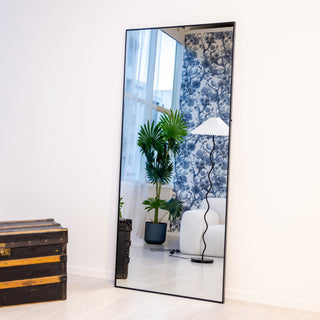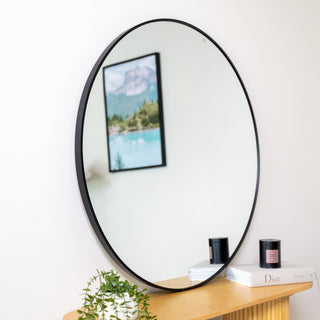Kia ora, mirror enthusiasts and curious minds!
Have you ever tried on an outfit in a store's dressing room and thought you looked fabulous, only to feel differently when you got home and looked in your own mirror? You're not alone. Many people notice that they appear slightly different in various full-length mirrors. But why does this happen?
In this blog post, we'll delve into the factors that can cause these variations. From the quality and construction of the mirror itself to lighting conditions and viewing angles, several elements can influence how we perceive our reflection. Understanding these factors can help you choose the right mirror and create the optimal setting for an accurate reflection.
1. Mirror Quality and Construction
a. Glass Thickness and Quality
The thickness and quality of the mirror's glass play a crucial role in the accuracy of the reflection.
- Glass Thickness: Mirrors typically come in thicknesses ranging from 2 mm to 6 mm. Thinner mirrors (like 2 mm) are more prone to bending and warping, which can distort the image. C&F Creation's mirrors use 2.8 mm to 4 mm thick ultra high-definition glass, ensuring a flat surface that provides a true reflection.
- Glass Quality: High-quality glass is free from impurities and inconsistencies that can cause distortions. Lower-quality mirrors might have slight waves or imperfections that alter your appearance.
Featured Product:
Zenith Straight-Edged Full-Length Freestanding Mirror
Our Zenith mirror boasts a 3 mm ultra high-definition glass that delivers crystal-clear reflections. Its premium quality ensures you see your true self without distortions.
b. Mirror Flatness and Surface Accuracy
- Warping: Over time or due to poor manufacturing, mirrors can warp or bend slightly. Even minimal deviations from flatness can stretch or compress the reflected image.
- Mounting Issues: How a mirror is mounted can affect its flatness. Mirrors that are not properly secured can flex, leading to distortions.
Featured Product:
Grandeur Arched Full-Length Freestanding Mirror
Designed with a robust frame and stand, the Grandeur mirror maintains perfect flatness whether freestanding or wall-mounted, ensuring an accurate reflection every time.
c. Reflective Coating
- Quality of Coating: The reflective layer (usually aluminium or silver) must be evenly applied. Inconsistent coatings can affect brightness and clarity.
- Protective Backing: A protective layer over the reflective coating prevents oxidation and degradation, maintaining the mirror's integrity over time.
C&F Creation Advantage:
Our mirrors feature high-quality silver nitrate coatings with protective backings, enhancing durability and providing superior reflectivity.
2. Lighting Conditions
a. Direction and Intensity of Light
Lighting dramatically influences how we perceive ourselves in a mirror.
- Direct Lighting: Harsh, direct light can cast unflattering shadows, highlighting textures and imperfections.
- Soft Lighting: Diffused or soft lighting reduces shadows and provides a more even illumination, often resulting in a more flattering reflection.
Tip: Position your mirror near a source of natural light or use ambient lighting to create a balanced illumination.
b. Light Temperature
- Warm Light: Emits a yellowish hue, creating a cosy atmosphere but can alter the appearance of colours, including skin tone.
- Cool Light: Has a bluish tint, which can make the reflection appear paler or more washed out.
- Natural Light: Generally provides the most accurate representation, but its variability throughout the day can change how you look.
Featured Product:
Prism Octagonal Full-Length Freestanding Mirror
The Prism mirror's unique shape allows it to capture and reflect light creatively, enhancing the ambiance of your space.
3. Viewing Angle and Distance
a. Angle of Observation
The angle at which you view yourself affects the proportions and perception of your reflection.
- Straight-On View: Looking directly at the mirror provides the most accurate representation.
- Tilted Mirror: A mirror angled forward or backward can elongate or shorten your appearance.
- Side Angles: Viewing from the side can alter the perception of depth and proportions.
Featured Product:
Arcadia Small Arched Full-Length Freestanding Mirror
With its adjustable stand, the Arcadia mirror allows you to find the perfect angle for the most accurate reflection.
4. Mirror Size and Shape
a. Mirror Dimensions
- Full-Length Mirrors: Provide a head-to-toe view, essential for assessing your entire outfit.
- Width of the Mirror: A narrow mirror may cut off parts of your image or create a cramped reflection.
C&F Creation Selection:
Our mirrors come in various sizes, like the Svelte Arched Mirror (160 cm x 60 cm), ensuring you find one that fits your space and provides a complete reflection.
b. Shape of the Mirror
- Flat Mirrors: Standard mirrors that provide an accurate reflection.
- Curved Mirrors: Convex or concave mirrors can intentionally distort the image for decorative effects.
Design Variety:
From the sleek straight edges of the Zenith mirror to the elegant arch of the Arcadia, C&F Creation offers shapes that suit your style without compromising on reflection accuracy.
5. Environmental Factors
a. Surrounding Colours and Décor
- Wall Colour: The colour of the wall behind or around the mirror can influence the overall lighting and mood.
- Adjacent Objects: Nearby colourful objects can reflect onto the mirror, altering the perception of colours.
Tip: Place your mirror against neutral-coloured walls to minimise colour reflections that may affect your appearance.
b. Room Size and Layout
- Small Spaces: Mirrors in confined areas might reflect more shadows, affecting the image.
- Open Spaces: Provide ample light and fewer obstructions, contributing to a clearer reflection.
Enhance Your Space:
Using larger mirrors like the Grandeur Arched Mirror can make smaller rooms feel more spacious and improve lighting conditions.
6. Psychological Factors
a. Perception and Mood
- Emotional State: Your mood can influence how you perceive your appearance. Feeling confident may make you see yourself more positively.
- Body Image: Personal perceptions and insecurities can affect how you interpret your reflection.
Positive Reflection:
Create a pleasant environment around your mirror with positive affirmations or decor that uplifts your mood.
Choosing the Right Mirror
Understanding these factors can help you select a mirror that provides the most accurate and flattering reflection.
Opt for High-Quality Mirrors
- Quality Materials: Choose mirrors made with high-quality glass and reflective coatings.
- Proper Thickness: A mirror with a thickness of 2.8 mm to 4 mm, like those offered by C&F Creation, ensures durability and minimal distortion.
Our Recommendation:
Explore our range of mirrors, such as the Facet Straight-Edged Full-Length Mirror, crafted to deliver exceptional clarity.
Consider Lighting Conditions
- Placement Near Natural Light: Position mirrors where they can benefit from natural light without direct sun exposure.
- Supplement with Lighting: Use soft, diffused lighting around the mirror to enhance visibility without harsh shadows.
Enhancing Your Reflection with C&F Creation Mirrors
At C&F Creation, we understand the importance of seeing your true self in the mirror.
- Ultra High-Definition Glass: Our mirrors use premium glass that provides clear, undistorted reflections.
- Thoughtful Design: With attention to detail in construction and aesthetics, our mirrors enhance both your space and your self-perception.
- Versatile Options: From wall-mounted to freestanding mirrors, we offer styles that suit your needs and décor.
Shop Our Collection:
Visit our Full-Length Mirrors Collection to find the perfect mirror that combines quality and style.
Final Thoughts
It's fascinating to realise how many factors can influence the way we see ourselves in different mirrors. By being aware of these elements, you can make informed choices about the mirrors you use and how you set up your space to ensure the most accurate and confidence-boosting reflections.
Remember, the next time you notice a difference in your appearance from one mirror to another, consider the mirror's quality, the lighting, and other environmental factors. Investing in a high-quality mirror and optimising your environment can make a significant difference.
Ngā mihi nui,
The C&F Creation Team










